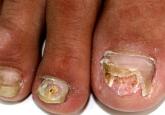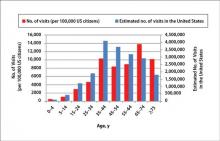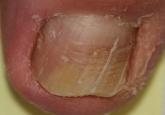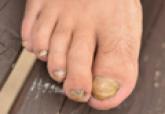Case Letter

In Vivo Confocal Microscopy in the Diagnosis of Onychomycosis
Onychomycosis is a common nail disease that frequently is caused by dermatophytes and is diagnosed by direct microscopy. Conventional diagnostic...
Arash Taheri, MD; Scott A. Davis, MA; Karen E. Huang, MS; Steven R. Feldman, MD, PhD
From the Center for Dermatology Research, Department of Dermatology, Wake Forest School of Medicine, Winston-Salem, North Carolina. Dr. Feldman also is from the Departments of Pathology and Public Health Sciences.
This study was supported in part by an investigator-initiated research grant from Valeant Pharmaceuticals International, Inc. Dr. Taheri, Mr. Davis, and Ms. Huang report no conflict of interest. Dr. Feldman is a consultant, researcher, and speaker for Novartis Corporation and a researcher for Anacor Pharmaceuticals, Inc.
Correspondence: Arash Taheri, MD, Department of Dermatology, Wake Forest School of Medicine, 4618 Country Club Rd, Winston-Salem, NC 27104 (arataheri@wakehealth.edu).

Results
During the 18-year study period, 636 visits with a diagnosis of onychomycosis were recorded in the NAMCS database. This unweighted number of visits corresponded with approximately 19,350,000 visits (an average of 1,075,000 visits per year) to physicians’ offices with a diagnosis of onychomycosis in the United States during this period. Among these visits, there were an estimated 4,250,000 visits with fungal nail infection as the only diagnosis (no other comorbidities recorded). The recorded visits included more female (57.6%) than male (42.4%) patients, and 85% of patients were white (Table). Patients aged 35 to 44 years accounted for the largest number of visits; however, the estimated rate of onychomycosis visits per 100,000 US citizens was highest among those aged 65 to 74 years (Figure 1).
 Figure 1. Health care utilization for onychomycosis from 1993 to 2010 stratified by patient age, as defined as: (1) the total estimated number of US outpatient visits that included a diagnosis of onychomycosis (right-hand y axis and blue bars), and (2) the estimated number of visits per 100,000 US citizens (left-hand y axis and red bars). To calculate the average number of visits per US citizen in a defined age group, the total number of visits for a given age group was divided by the estimated population size for that age group.
Figure 1. Health care utilization for onychomycosis from 1993 to 2010 stratified by patient age, as defined as: (1) the total estimated number of US outpatient visits that included a diagnosis of onychomycosis (right-hand y axis and blue bars), and (2) the estimated number of visits per 100,000 US citizens (left-hand y axis and red bars). To calculate the average number of visits per US citizen in a defined age group, the total number of visits for a given age group was divided by the estimated population size for that age group.
The number of US outpatient visits with a recorded diagnosis of onychomycosis increased from 1993 to 2010 (Figure 2); however, there was no change in the ratio of onychomycosis visits to the total number of recorded visits in NAMCS database during the study period (P=.9). A combined total of 91% of onychomycosis visits were to general and family practitioners, dermatologists, or internal medicine practitioners (Figure 3). Although cardiovascular diseases and diabetes mellitus accounted for a large proportion of comorbidities, conditions affecting the feet (eg, tinea pedis, ingrown nails) also were among the most common comorbidities (Figure 4).
Figure 2. Estimated number of US outpatient visits with a recorded diagnosis of onychomycosis per year (1993-2010). Solid line represents the linear regression best fit line. Figure 3. Estimated number of US outpatient visits with a recorded diagnosis of onychomycosis by specialty (1993-2010). Figure 4. Top 10 comorbidities observed at US outpatient visits with a recorded diagnosis of onychomycosis (1993-2010). |
In both topical and systemic form, terbinafine was the most commonly prescribed antifungal agent, followed by systemic fluconazole, systemic itraconazole, and topical ciclopirox (Figure 5). Over the 18-year study period, there was an increasing trend in the frequency of terbinafine prescription (regression coefficient [r]=0.01319; P=.004); a decreasing trend for fluconazole (r=-0.0053851; P=.04), itraconazole (r=-0.0113988; P<.001), griseofulvin (r=-0.0073942; P<.001), and econazole prescription (r=-0.0032405; P=.01); and no significant trend for ketoconazole (r=-0.0034553; P=.1), naftifine (r=-0.0029067; P=.06), sulconazole (r=-0.0001619; P=.8), ciclopirox (r=0.0032684; P=.1), and miconazole prescription (r=0.0002074; P=.5).
Eighty-six percent of visits were for established patients who had been seen in the related office with any diagnosis before the recorded visit and 14% of visits were for new (first-time) patients. Fluconazole was the most frequently used antifungal drug for new patients, while terbinafine was the most frequently used in other visits. Terbinafine was the most frequently prescribed antifungal drug by general and family practitioners, dermatologists, internal medicine practitioners, and all other specialties not listed.
Terbinafine was the most frequently prescribed antifungal drug in both genders and in white and black patients. Itraconazole was the most frequently prescribed antifungal drug for Hispanic patients and those of other ethnicities not listed. Terbinafine was the most frequently prescribed antifungal drug for patients with diabetes and obesity (ie, body mass index ≥30). In 19,330,000 of 19,350,000 total estimated visits included in this study, onychomycosis was the only diagnosis with a potential indication for an antifungal drug therapy, ruling out the possibility that fluconazole or other drugs were used for patients who also had candidiasis or “other specified erythematous conditions.”

Onychomycosis is a common nail disease that frequently is caused by dermatophytes and is diagnosed by direct microscopy. Conventional diagnostic...

Onychomycosis is a fungal infection of the nail plate by dermatophytes, yeasts, and nondermatophyte molds.

Onychomycosis is a chronic fungal infection of the nails that is largely underdiagnosed in developing countries such as India due to poor health...
